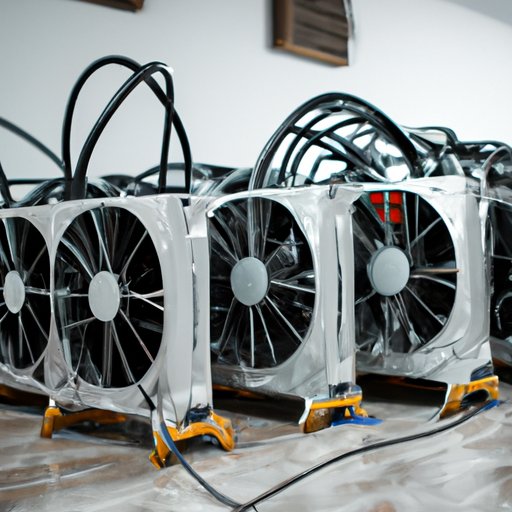Introduction
Cryptocurrency mining is the process of verifying and adding transaction records to a public ledger, known as a blockchain. This process is carried out by miners, individuals who devote their computer processing power to solving complex mathematical problems. In exchange, miners are rewarded with a portion of the cryptocurrency they’re mining. As cryptocurrencies continue to gain popularity, more and more people are interested in becoming miners. But what does a crypto miner do, and how can you become one? In this article, we’ll explore the basics of crypto mining and provide a step-by-step guide on how you can become a miner.
Overview of Crypto Mining
Crypto mining is the process of verifying and adding new transactions to a blockchain network. A blockchain is a digital ledger that records every transaction made on a network. Every time a user sends or receives cryptocurrency, a new transaction record is added to the blockchain. To prevent fraud and ensure security, these transactions must be verified by miners. Miners use powerful computers to solve complex cryptographic puzzles. When a miner successfully solves a puzzle, they are rewarded with a portion of the cryptocurrency they’re mining.
Different Types of Crypto Mining
There are three main types of crypto mining: CPU mining, GPU mining, and ASIC mining. Each has its own advantages and disadvantages.
CPU Mining
CPU mining uses a computer’s central processing unit (CPU) to mine cryptocurrency. It is the most basic type of mining and is relatively easy to set up. However, it is also the least efficient, as CPUs are not designed for intensive calculations. Additionally, CPU mining consumes a lot of electricity, making it an expensive option.
GPU Mining
GPU mining uses a computer’s graphics processing unit (GPU) to mine cryptocurrency. GPUs are more powerful than CPUs and can generate more hash power, making them much more efficient for mining. GPU mining is also more cost-effective than CPU mining, as GPUs consume less electricity.
ASIC Mining
ASIC mining stands for application-specific integrated circuit mining. Unlike CPUs and GPUs, which can be used for other tasks, ASICs are specifically designed for mining. They are much more powerful and energy-efficient than other types of mining hardware, making them the most popular choice for miners. However, ASICs are also the most expensive type of mining hardware.

Benefits and Risks of Crypto Mining
Crypto mining offers several benefits, including the potential to earn cryptocurrency rewards and increased security for the blockchain network. However, there are also some risks associated with mining, such as high electricity costs and the risk of hardware failure.
Benefits
The primary benefit of crypto mining is the potential to earn cryptocurrency rewards. By dedicating your computing power to verifying transactions, you can earn a portion of the cryptocurrency you’re mining. Additionally, crypto mining helps secure the blockchain network by verifying transactions and preventing fraud.
Risks
The biggest risk of crypto mining is the cost of electricity. Depending on where you live, electricity costs can be quite high. Additionally, mining hardware is prone to failure, which can result in significant losses. Finally, the reward for mining is not guaranteed, as the difficulty of the puzzles can vary significantly.
Step-by-Step Guide to Becoming a Crypto Miner
If you’re interested in becoming a crypto miner, here’s a step-by-step guide to get you started.
Hardware Requirements
The first step to becoming a crypto miner is to purchase the necessary hardware. If you’re just getting started, a CPU or GPU will suffice. However, if you’re looking to maximize your profits, you should consider investing in an ASIC miner. ASIC miners are the most powerful and energy-efficient option, but they are also the most expensive.
Software Requirements
In addition to hardware, you’ll need to install mining software on your computer. Popular options include CGMiner, BFGMiner, and MultiMiner. Each of these programs has its own unique features, so be sure to research each one before deciding which one to use.
Joining a Pool
Once you’ve selected your hardware and software, the next step is to join a mining pool. A mining pool is a group of miners who work together to increase their chances of earning rewards. By joining a pool, you can combine your computing power with other miners and increase your chances of finding a block and receiving a reward.
Configuring Software Settings
Once you’ve joined a mining pool, you’ll need to configure your mining software settings. The settings will vary depending on your hardware, but most mining software has straightforward menus that make it easy to adjust the settings.
Mining Profitability
Finally, you’ll need to calculate your mining profitability. This involves taking into account your hardware and electricity costs, as well as the current market price of the cryptocurrency you’re mining. You can use online calculators to help you determine whether or not mining is profitable for you.

Examining the Future of Crypto Mining
Crypto mining is an ever-evolving industry, and it’s important to keep up with the latest trends. Here are some of the challenges and opportunities facing miners today.
Challenges Facing Crypto Miners
One of the biggest challenges facing miners is increasing competition. As more people enter the mining space, the difficulty of the puzzles increases, making it harder to find blocks and earn rewards. Additionally, the rising cost of electricity is another challenge miners must contend with. As electricity prices rise, miners may find it difficult to remain profitable.
Opportunities for Crypto Mining
Despite the challenges, there are still plenty of opportunities for miners. For example, many miners are now turning to renewable energy sources to power their operations. Additionally, new technologies, such as cloud mining, are opening up new possibilities for miners. Finally, the growth of the crypto market means that there is still plenty of money to be made.
Conclusion
Crypto mining is the process of verifying and adding transactions to a blockchain network. Different types of mining hardware can be used, each with its own advantages and disadvantages. Mining offers the potential to earn rewards and increased security for the blockchain network, but it also carries certain risks, such as high electricity costs and hardware failure. If you’re interested in becoming a miner, be sure to research the hardware and software requirements, join a mining pool, and calculate your mining profitability. The crypto mining industry is constantly evolving, so it’s important to stay up to date on the latest developments.
(Note: Is this article not meeting your expectations? Do you have knowledge or insights to share? Unlock new opportunities and expand your reach by joining our authors team. Click Registration to join us and share your expertise with our readers.)
